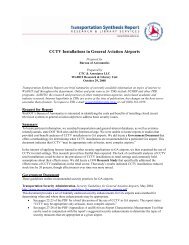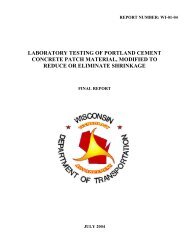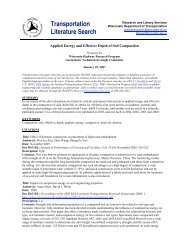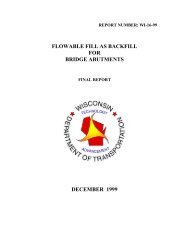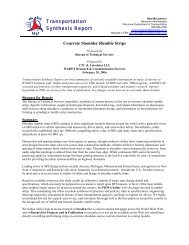Improved Life for Longitudinal Joints in Asphalt Pavement - WisDOT ...
Improved Life for Longitudinal Joints in Asphalt Pavement - WisDOT ...
Improved Life for Longitudinal Joints in Asphalt Pavement - WisDOT ...
Create successful ePaper yourself
Turn your PDF publications into a flip-book with our unique Google optimized e-Paper software.
Ma<strong>in</strong>e“<strong>Longitud<strong>in</strong>al</strong> Jo<strong>in</strong>t Study,” Federal Experimental Report 96-2, September 2001.http://ma<strong>in</strong>egov-images.<strong>in</strong><strong>for</strong>me.org/mdot/transportation-research/pdf/report9602f.pdfThis five-year study of longitud<strong>in</strong>al jo<strong>in</strong>ts constructed <strong>in</strong> 1996 evaluated various methods of longitud<strong>in</strong>al jo<strong>in</strong>tconstruction dur<strong>in</strong>g roll<strong>in</strong>g of HMA pavement. Jo<strong>in</strong>t-mak<strong>in</strong>g equipment, roll<strong>in</strong>g patterns, edge trimm<strong>in</strong>g and othertechniques were evaluated <strong>in</strong> various comb<strong>in</strong>ations. The best per<strong>for</strong>mance was <strong>in</strong> the section <strong>in</strong> which roll<strong>in</strong>g wasconducted from the cold mat with a 6-<strong>in</strong>ch overlap <strong>in</strong>to the hot mat; this method is the reverse of the recommendedmethod by NCAT and other studies.New Hampshire“Field Trial of Infrared Jo<strong>in</strong>t Heater to Improve <strong>Longitud<strong>in</strong>al</strong> Jo<strong>in</strong>t Per<strong>for</strong>mance <strong>in</strong> New Hampshire,” Jo Sias Daniel,University of New Hampshire, and William Real, NHDOT; Transportation Research Record No. 1946, 2006: 157-162. (See attached file.)This field study evaluated the use of <strong>in</strong>frared jo<strong>in</strong>t heaters to improve longitud<strong>in</strong>al jo<strong>in</strong>t per<strong>for</strong>mance. The heateressentially affects only the top layer of the full-depth asphalt structure, suggest<strong>in</strong>g potential <strong>for</strong> us<strong>in</strong>g this methodwith overlays.Ontario“<strong>Longitud<strong>in</strong>al</strong> Jo<strong>in</strong>t Compaction: Improv<strong>in</strong>g Paved Lanes,” Road Talk, Vol. 10 (2), May 2004.http://www.mto.gov.on.ca/english/transtek/roadtalk/rt10-2/<strong>in</strong>dex.html#jo<strong>in</strong>tThe Ontario M<strong>in</strong>istry of Transportation evaluated the use of <strong>in</strong>centives and test<strong>in</strong>g of density at jo<strong>in</strong>ts to ensure thatjo<strong>in</strong>ts were constructed as specified. Investigators evaluated the long-term per<strong>for</strong>mance of four trial sections paved<strong>in</strong> 1997 <strong>in</strong> which compaction was tested at the longitud<strong>in</strong>al jo<strong>in</strong>ts to ensure contractor compliance, not a requirementat the time. Trials <strong>in</strong>cluded both standard and unconventional methods and equipment. Highlights <strong>in</strong>clude:• Four methods were evaluated, <strong>in</strong>clud<strong>in</strong>g standard pav<strong>in</strong>g and compaction, use of a jo<strong>in</strong>t heater, use of ajo<strong>in</strong>t-build<strong>in</strong>g system with a compactor and kicker-plates as well as an electronic monitor<strong>in</strong>g device, anduse of both a heater and the jo<strong>in</strong>t<strong>in</strong>g and monitor<strong>in</strong>g system.• No method proved superior to the others, but all achieved compaction rates of 95 percent or greater.• After four years and after six years, jo<strong>in</strong>ts were <strong>in</strong> excellent condition.• Contractor per<strong>for</strong>mance has been encouraged through bonuses <strong>for</strong> meet<strong>in</strong>g standards on 95 percent or moreof exam<strong>in</strong>ed edges, and penalties <strong>for</strong> meet<strong>in</strong>g standards at 90 percent or less of exam<strong>in</strong>ed edge po<strong>in</strong>ts.PennsylvaniaEvaluation of Eight <strong>Longitud<strong>in</strong>al</strong> Jo<strong>in</strong>t Construction Techniques <strong>for</strong> <strong>Asphalt</strong> <strong>Pavement</strong>s <strong>in</strong> Pennsylvania, PrithviKandhal, Timothy Ramirez and Paul Ingram, NCAT Report No. 2002-03, February 2002.http://www.eng.auburn.edu/center/ncat/reports/rep02-03.pdfFollow<strong>in</strong>g up on some of the sites <strong>in</strong>cluded <strong>in</strong> the 1997 NCAT study, researchers evaluated the six-year per<strong>for</strong>manceof the eight techniques used <strong>in</strong> Pennsylvania <strong>in</strong> 1995. F<strong>in</strong>d<strong>in</strong>gs <strong>in</strong>cluded:• <strong>Jo<strong>in</strong>ts</strong> us<strong>in</strong>g rubberized jo<strong>in</strong>t material had per<strong>for</strong>med best.• The jo<strong>in</strong>t constructed us<strong>in</strong>g a cutt<strong>in</strong>g wheel was a close second.• Sections on which roll<strong>in</strong>g from the hot side away from the jo<strong>in</strong>t was used per<strong>for</strong>med reasonably well.• The New Jersey wedge jo<strong>in</strong>t per<strong>for</strong>med reasonably well.TexasDensity Evaluation of the <strong>Longitud<strong>in</strong>al</strong> Construction Jo<strong>in</strong>t of Hot-Mix <strong>Asphalt</strong> <strong>Pavement</strong>s, C<strong>in</strong>dy Estakhri, ThomasFreeman and Clif<strong>for</strong>d Spiegelman, Texas Transportation Institute: April 2001.http://tti.tamu.edu/documents/1757-1.pdfThis Texas study of density <strong>in</strong> longitud<strong>in</strong>al jo<strong>in</strong>ts <strong>in</strong> HMA evaluated jo<strong>in</strong>ts at 35 sites, considered airfield andpavement regulations, and conducted laboratory tests. One of the study’s goals was to identify the viability of adensity specification <strong>for</strong> longitud<strong>in</strong>al jo<strong>in</strong>ts <strong>in</strong> asphalt pavement, and <strong>in</strong>vestigators developed and proposed aspecification. F<strong>in</strong>d<strong>in</strong>gs <strong>in</strong>clude:• Some states and the Federal Aviation Adm<strong>in</strong>istration ma<strong>in</strong>ta<strong>in</strong> a density specification <strong>for</strong> longitud<strong>in</strong>al jo<strong>in</strong>ts<strong>in</strong> asphalt, and contractors have little trouble meet<strong>in</strong>g the requirement.• Density was always lower at the unconf<strong>in</strong>ed edge of the pavement than at the middle of the lane. Thedifference averaged about 4 to 5 percent, about 6 to 7 pounds per cubic foot.• The proposed specification would require the difference to be kept to 5 pounds per cubic foot.4



